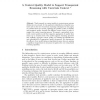PERCOM
2007
ACM
14 years 6 months ago
2007
ACM
The CARE middleware aims at supporting contextaware adaptation of Internet services in a mobile computing environment. The CARE hybrid reasoning mechanism is based on a loose inte...
IAT
2007
IEEE
14 years 6 months ago
2007
IEEE
Practical reasoning (PR), as advocated by philosophers is concerned by reasoning about what agents should do. It follows mainly two steps. A deliberation one for identifying the g...
MOBIQUITOUS
2008
IEEE
14 years 6 months ago
2008
IEEE
A fundamental requirement for autonomic computing is to be able to automatically infer how human users react in similar contextual conditions. This paper examines the problem of a...
ICAS
2008
IEEE
14 years 6 months ago
2008
IEEE
Abstract—A growing number of applications start using Semantic Web technologies. The base concept in this technology is the use of ontologies, allowing first-order logic reasoni...
BLISS
2008
IEEE
14 years 6 months ago
2008
IEEE
The CSISM project is designing and implementing an automated cyberdefense decision-making mechanism with expert-level ability. CSISM interprets alerts and observations and takes d...
TLCA
2009
Springer
14 years 6 months ago
2009
Springer
Types play an important role both in reasoning about Haskell and for its implementation. For example, the Glasgow Haskell Compiler performs certain fusion transformations that are...
SEMWEB
2009
Springer
14 years 6 months ago
2009
Springer
Abstract. Semantic applications that utilise OWL ontologies can benefit from a broad range of OWL reasoning systems, which allow for the inference of implicit knowledge from expli...
RR
2009
Springer
14 years 6 months ago
2009
Springer
Abstract. The Semantic Web is commonly perceived as a web of partially interlinked machine readable data. This data is inherently distributed and resembles the structure of the web...
QUACON
2009
Springer
14 years 6 months ago
2009
Springer
Much research on context quality in context-aware systems divides into two strands: (1) the qualitative identi
cation of quality measures and (2) the use of uncertain reasoning tec...
IDC
2009
Springer
14 years 6 months ago
2009
Springer
Abstract. Based on the plethora of proposals and standards for logic- and rulebased reasoning for the Semantic Web (SW), a key factor for the success of SW agents is interoperabili...



